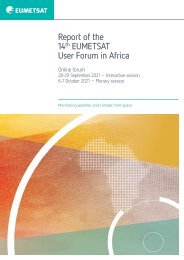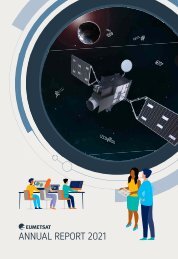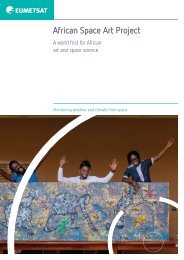EUMETSAT Annual Report 2022
Create successful ePaper yourself
Turn your PDF publications into a flip-book with our unique Google optimized e-Paper software.
<strong>EUMETSAT</strong> ANNUAL REPORT <strong>2022</strong><br />
Case study<br />
Meteosat<br />
Third Generation:<br />
cutting-edge weather data<br />
As devastating storms, floods, and other<br />
extreme weather events become more<br />
frequent, it is essential to monitor the<br />
Earth’s complex systems.<br />
Thousands of researchers and data users attended<br />
the European Space Agency’s Living Planet<br />
Symposium in Bonn, Germany, in May, to tackle<br />
that formidable challenge. One of the world’s largest<br />
Earth observation conferences, the symposium<br />
provided experts with an opportunity to exchange<br />
ideas on how satellites can best be used to collect<br />
information about the planet – from monitoring<br />
wetlands, forests, and biodiversity, to tracking<br />
the health of the oceans and keeping tabs on<br />
diminishing Arctic sea ice, to measuring greenhouse<br />
gases in the atmosphere.<br />
A highlight of the event was presentations about<br />
<strong>EUMETSAT</strong>’s Meteosat Third Generation (MTG)<br />
system. MTG-Imager 1, the first satellite in the<br />
system, was launched on 13 December.<br />
“We are really excited about the new MTG satellites,”<br />
Dr Tony McNally, Head of Earth System Assimilation<br />
at the European Centre for Medium-Range Weather<br />
Forecasts (ECMWF), said.<br />
“The observations that we’ll receive from these<br />
satellites will be critical for many applications,<br />
including accurate forecasts of severe weather. The<br />
MTG satellite could capture the genesis or rapid<br />
intensification of a tropical cyclone in the Atlantic –<br />
that’s literally a life or death situation for the people<br />
of the Caribbean.”<br />
Game changers<br />
McNally is looking forward to a few instruments<br />
in particular that will further improve weather<br />
forecasts by providing even better pictures of fastevolving<br />
meteorological systems. These include<br />
the Flexible Combined Imager on MTG-I1 and the<br />
Infrared Sounder on the second satellite, the sounder,<br />
expected to launch in 2024.<br />
“The Flexible Combined Imager will be a really big<br />
step up,” McNally said. “We will get 16 channels,<br />
which enable us to tune in to different features of the<br />
atmosphere, similar to how different radio stations<br />
play different types of music. More channels mean<br />
more information, and from each individual channel<br />
we will get better spatial detail. Importantly, we’ll also<br />
receive more rapid updates.<br />
“Then, the Infrared Sounder on the following<br />
MTG satellite is going to be an absolutely gamechanging<br />
instrument. With more than a thousand<br />
channels, as is the case with this instrument,<br />
we can build up a three-dimensional, timeevolving<br />
picture of the atmospheric state with<br />
unprecedented vertical detail.”<br />
McNally is also eagerly anticipating the data that will<br />
come from a brand new instrument on MTG imaging<br />
satellites, the Lightning Imager. The four cameras<br />
on board will collect continuous, near-real-time<br />
data about intracloud, cloud-to-cloud, and cloud-toground<br />
lightning flashes. This information can be<br />
used to identify highly unstable and dynamic regions<br />
of the atmosphere – again critical for accurate<br />
weather forecasts.<br />
16









